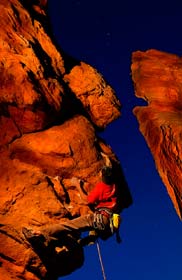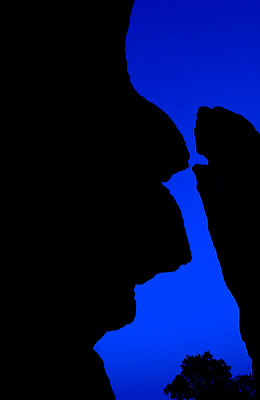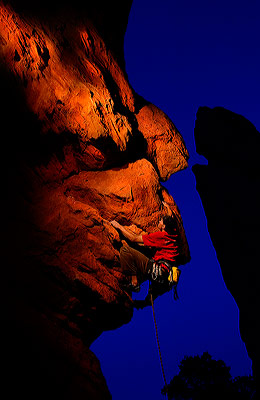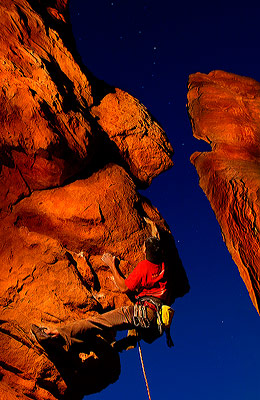 Hi and welcome to this edition of Workshop at the Ranch. I am always looking for something new when it comes to making pictures and expanding my photographic horizon. Rock climbing was not a venue I had in mind but I’m all “AMPED UP” thanks to the enthusiasm of fellow photographer Keith Ladzinski. Keith is a very talented photographer who covers a variety of outdoor adventure sports. During lunch the other day he mentioned something about Night Rock Climbing and the wheels began turning in my head…..Keith’s expertise of both photography and climbing inspired me to say…OK…..Let’s do it! So, here’s a look……….
Hi and welcome to this edition of Workshop at the Ranch. I am always looking for something new when it comes to making pictures and expanding my photographic horizon. Rock climbing was not a venue I had in mind but I’m all “AMPED UP” thanks to the enthusiasm of fellow photographer Keith Ladzinski. Keith is a very talented photographer who covers a variety of outdoor adventure sports. During lunch the other day he mentioned something about Night Rock Climbing and the wheels began turning in my head…..Keith’s expertise of both photography and climbing inspired me to say…OK…..Let’s do it! So, here’s a look……….
Hi and welcome to this edition of Workshop at the Ranch. I am always looking for something new when it comes to making pictures and expanding my photographic horizon. Rock climbing was not a venue I had in mind but I’m all “AMPED UP” thanks to the enthusiasm of fellow photographer Keith Ladzinski. Keith is a very talented photographer who covers a variety of outdoor adventure sports. During lunch the other day he mentioned something about Night Rock Climbing and the wheels began turning in my head…..Keith’s expertise of both photography and climbing inspired me to say…OK…..Let’s do it! So, here’s a look……….
 Image #1 Step 1…..(Image Captured at 7:45pm) I think “crazy” best describes what these climbers are doing after the sun goes down. Brian is one of the regions strongest climbers and was my subject for the evening. We arrived on location about 30 minutes before sunset and chose an area that offered me some access to setup my Nikon D2X on a Bogen Tripod and position my Nikon SB800 Speedlights. I used a Nikon 17-55mm Lens and composed the scene. I set the exposure for the sky and used a WB of 3700K. The 3700K WB would help add a cool blue tone to the Eastern sky. As the sun set behind me it became twilight. I will set the D2X on Long Exposure Noise Reduction mode. I have an exposure of ISO 100, 1 second at f9. I have created a silhouette of the rock and nothing more. Now I’m ready for Brian to climb.. Image #1 Step 1…..(Image Captured at 7:45pm) I think “crazy” best describes what these climbers are doing after the sun goes down. Brian is one of the regions strongest climbers and was my subject for the evening. We arrived on location about 30 minutes before sunset and chose an area that offered me some access to setup my Nikon D2X on a Bogen Tripod and position my Nikon SB800 Speedlights. I used a Nikon 17-55mm Lens and composed the scene. I set the exposure for the sky and used a WB of 3700K. The 3700K WB would help add a cool blue tone to the Eastern sky. As the sun set behind me it became twilight. I will set the D2X on Long Exposure Noise Reduction mode. I have an exposure of ISO 100, 1 second at f9. I have created a silhouette of the rock and nothing more. Now I’m ready for Brian to climb..
|
 Image #2 Step 2…..(Image Captured at 8:00pm) My Nikon D2X is about 20 feet away from the rock that Brian will climb. I have set my exposure for the sky (slightly darker than image #1 because the sun continues to set), thus creating a silhouette. I will now add my own light to reveal my subject by using the Nikon SB800 Speedlight system. I will use two Remote SB800s that I have attached to my Bogen Monopod using the Bogen 175F Clamp (a.k.a. the Justin Clamp). I want to locate my SB800s to the left and above Brian so as to have some deep shadow areas on the rocks creating a dramatic look to the scene. I will point one SB800 at the rock and the other SB800 at Brian. I have a third SB800 that is the MASTER and is located on the hotshoe of my D2X (this would be a good time to review some of the past editions of Workshop at the Ranch for examples and setup information regarding the Nikon SB800 Speedlight systems). I will also use the Warming Gel that comes with the SB800 kit to add warmth to the rocks and Brian (remember I have chosen a WB of 3700K to add a cool blue tone to the sky…the warming gel will offset the cool tone and warm up Brian and the rock). I will need to climb up to my position to Brian’s left and lift up the monopod with my SB800s to achieve the angle of light I want. I will need to set the camera on SELF TIMER to have enough time to trigger the camera and get into my position before the shutter is released…..10 seconds was enough time for me position myself. The remote SB800 pointed at the rock is about 4 feet from the rock and is set at +0.7 while the remote SB800 pointed at Brian is about 12 feet from him and is set at +2.7. Both SB800s are zoomed to 105mm. Remember, I do not want light spilling everywhere and the zoom feature helps me channel the light the way grids or barndoors would on a studio strobe. I like the image very much but feel there is more I can do to really tell the story of night rock climbing. |
 Image #3 Step 3…..(Image Captured at 8:30pm) Image #3 Step 3…..(Image Captured at 8:30pm) So far, so good but l want to really illustrate Night Rock Climbing to the viewer I will need to bring more elements to the image. As night falls my sky exposure will continually change. I must add more time and a wider aperture to compensate for the darkening sky. I also realize that with a longer exposure I will be able to utilize some lightpainting to reveal the rock spire in the background. The longer exposure and wider aperture will also reveal the stars in the sky above Brian. In just 30 minutes our exposure has changed dramatically. My Nikon D2X has been repositioned about 12 inches to the right so as to separate the rock and spire a little more. My D2X is now set at ISO100, 30 seconds at f4, WB3700K and the Self Timer is set at 10 seconds. My remote SB800s are set the same as the previous image, +0.7 on the rock and +2.7 on Brian. I decided to zoom in slightly with my 17-55mm lens to remove the tree in the lower right-hand corner. I have set my 2 Million Candle Power Vector Sport Spot about 50 feet away from the camera and I am ready to shoot. I press the shutter release button and the Self Timer begins. It takes me 10 seconds to climb to my position, hold up the monopod with my SB800s and …….”CLICK / FLASH,” the SB800s flash as the shutter is released and my 30 second exposure time begins. It takes me 15 seconds to climb down and walk over to the Vector Sport Spot. I placed a 20 degree grid over the front of the Sport Spot and LightPaint the rock spire that is about 50 yards away for the remaining 15 seconds of my 30 seconds of exposure time. “CLICK” the shutter closes and the one frame is complete. The star field above Brian is clearly visible and the spire revealed from its silhouette. The SB800s with the warming gel did a nice job of lighting the rocks and Brian. I love this image and see great potential for future pictures of this exciting sport. |
I hope you have enjoyed this edition of Workshop at the Ranch. I was not on assignment for this shoot but was compelled to expand my photographic knowledge when Keith told me about this exciting new sport. I believe all photographers need to experiment and stretch themselves in an effort to learn and improve. Thanks Keith for sharing your time and expertise during a great evening of learning and picture making. See you all next time here at
Workshop at the Ranch………………………..Adios, Dave
![]() Hi and welcome to this edition of Workshop at the Ranch. I am always looking for something new when it comes to making pictures and expanding my photographic horizon. Rock climbing was not a venue I had in mind but I’m all “AMPED UP” thanks to the enthusiasm of fellow photographer Keith Ladzinski. Keith is a very talented photographer who covers a variety of outdoor adventure sports. During lunch the other day he mentioned something about Night Rock Climbing and the wheels began turning in my head…..Keith’s expertise of both photography and climbing inspired me to say…OK…..Let’s do it! So, here’s a look……….
Hi and welcome to this edition of Workshop at the Ranch. I am always looking for something new when it comes to making pictures and expanding my photographic horizon. Rock climbing was not a venue I had in mind but I’m all “AMPED UP” thanks to the enthusiasm of fellow photographer Keith Ladzinski. Keith is a very talented photographer who covers a variety of outdoor adventure sports. During lunch the other day he mentioned something about Night Rock Climbing and the wheels began turning in my head…..Keith’s expertise of both photography and climbing inspired me to say…OK…..Let’s do it! So, here’s a look………. 




